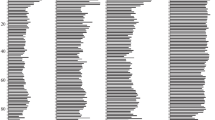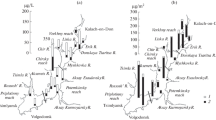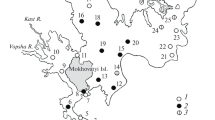Abstract
This study analyzes the data of spectrophotometric determination of plant pigments in the bottom sediments of Lake Nero based on bottom survey data of 2017. A low variability (Cv = 27–31%) in concentrations of chlorophyll a and pheopigments over the bottom area and vertically in the sapropel cores is established. The values of pigment concentrations in bottom sediments of the lake belong to the hypertrophic category. The hypertrophic state of the lake with respect to the pigment content (>300 μg/g of dry sediment) is maintained for the period of formation of an 80-cm sapropel layer (~800 years). Trends towards an increase in concentrations of plant pigments from the lower to upper layers of cores are revealed upon a significant relationship with concentrations of organic matter and total nitrogen, which indicates the natural eutrophication of the lake.




Similar content being viewed by others
REFERENCES
Alimov, A.F. and Golubkov, M.S., Lake eutrophication and community structure, Inland Water Biol., 2014, vol. 7, no. 3, p. 185. https://doi.org/10.1134/S1995082914030031
Arinushkina, E.V., Rukovodstvo po khimicheskomu analizu pochv (Guidance on Chemical Analysis of Soils), Moscow: Mosk. Gos. Univ., 1970.
Borisov, V.A., Uspenskaya, O.N., Grenaderov, N.V., and Vasyuchkov, I.Yu., Composition of organic substances of various types of sapropel, Agrokhimiya, 2014, no. 8, p. 51.
Bul’on, V.V., Does natural eutrophication of lakes occur?, Water Resour., 1998, vol. 25, no. 6, p. 701.
Butorin, N.V., Ziminova, N.A., and Kurdin, V.P., Donnye otlozheniya verkhnevolzhskikh vodokhranilishch (Bottom Sediments in the Upper Volga Reservoirs), Leningrad: Nauka, 1975.
Cherevichko, A.V., Succession of zooplankton of swampy lakes and wetlands of lake origin, Tr. Inst. Biol. Vnutr. Vod Ross. Akad. Nauk, 2017, no. 79 (82), p. 278.
Cremona, F., Laas, A., Arvola, L., et al., Numerical exploration of the planktonic to benthic primary production ratios in lakes of the Baltic Sea catchment, Ecosystems, 2016, vol. 19, p. 1386. https://doi.org/10.1007/s10021-016-0006-y
Datsenko, Yu.S., Comment on “Does natural eutrophication of lakes occur?” by V.V. Bul’on, Water Resour., 1998, vol. 25, no. 6, p. 707.
Datsenko, Yu.S., Evtrofirovanie vodokhranilishch. Gidrologo-gidrokhimicheskie aspekty (Eutrophication of Reservoirs: Hydrological and Hydrochemical Aspects), Moscow: GEOS, 2007.
Eutrophication of Waters. Monitoring, Assessment and Control, Paris: OECD, 1982.
Gebrehiwot, M., Kifle, D., Stiers, I., and Triest, L., Phytoplankton functional dynamics in a shallow polymictic tropical lake: the influence of emergent macrophytes, Hydrobiologia, 2017, vol. 797, no. 1, p. 69. https://doi.org/10.1007/s10750-017-3161-z
GOST 26107-84. Pochvy. Metody opredeleniya obshchego azota (GOST 26107-84. Soils. Methods for Determination of Total Nitrogen),1984.
Guilizzoni, P., Bonomi, G., Galanti, G., and Ruggiu, D., Relationship between sedimentary pigments and primary production; evidence from core analyses of twelve Italian lakes, Hydrobiologia, 1983, vol. 103, no. 1, p. 103. https://doi.org/10.1007/BF00028436
Izmest’eva, L.R., Silow, E.A., and Litchman, E., Long-term dynamics of lake baikal pelagic phytoplankton under climate change, Inland Water Biol., 2011, vol. 4, no. 3, p. 301. https://doi.org/10.1134/S1995082911030102
Khenderson-Sellers, B. and Marklend, Kh., Umirayushchie ozera. Prichiny i kontrol' antropogennogo evtrofirovaniya (Dying Lakes: The Causes and Control of Anthropogenic Eutrophication), Leningrad: Gidrometeoizdat, 1990.
Kurzo, B.V., Navosha, Yu.Yu., and Strigutskii, V.P., Formation of sapropel in the lakes of Belarus, Solid Fuel Chem., 2017, vol. 51, no. 5, p. 326. https://doi.org/10.3103/S0361521917050032
Lazareva, V.I., Struktura i dinamika zooplanktona Rybinskogo vodokhranilishcha (Structure and Dynamics of Zooplankton in the Rybinsk Reservoir), Moscow: KMK, 2010.
Lorenzen, C.J., Determination of chlorophyll and phaeo-pigments: spectrophotometric equations, Limnol., Oceanogr, 1967, vol. 12, no. 2, p. 343. https://doi.org/10.4319/lo.1967.12.2.0343
Mal’tsev, A.E., Leonova, G.A., Bobrov, V.A., and Krivonogov, S.K., Geochemical features of the Holocene section of sapropel in Lake Minzelinskoe (Western Siberia), Izv. Tomsk. Politekh.Univ., 2014, vol. 325, no. 1, p. 83.
Martynova, M.V. and Shmideberg, N.A., On methods for determining various forms of phosphorus in bottom sediments, Gidrokhim.Mater., 1983, vol. 85, p. 49.
Möller, W.A.A. and Scharf, B.W., The content of chlorophyll in the sediment of the volcanic maar lakes in the Eifel region (Germany) as an indicator for eutrophication, Hydrobiologia, 1986, vol. 143, no. 1, p. 327. https://doi.org/10.1007/BF00026678
Platonov, V.A., Khadartsev, A.A., Fridzon, K.Ya., and Chunosov, S.N., Chemical composition and biological activity of sapropel of Lake Glubokoe (Tatarstan), Vestn. Nov. Med. Tekhnol., 2014, vol. 21, no. 3, p. 199.
Pyrina, I.L., Litvinov, A.S., Kuchai, L.A., et al., Long-term changes of the primary production of phytoplankton in the Rybinsk Reservoir in connection with the influence of climatic factors, in Sostoyanie i problemy produktsionnoi gidrobiologii (Status and Problems of Production Hydrobiology), Moscow: KMK, 2006, p. 36.
Sánchez, M.L., Rodríguez, P., Torremorell, A.M., Izaguirre, I., and Pizarro, H., Phytoplankton and periphyton primary production in clear and turbid shallow lakes: influence of the light environment on the interactions between these communities, Wetlands, 2017, vol. 37, no. 1, p. 67. https://doi.org/10.1007/s13157-016-0840-x
Sidelev, S.I., Babanazarova, O.V., and Rychkova, E.N., Long-term changes in the concentrations of chlorophyll a in a shallow highly eutrophic lake, in Vodnye ekosistemy: troficheskie urovni i problemy podderzhaniya bioraznoobraziya (Aquatic Ecosystems: Trophic Levels and Problems of Maintaining Biodiversity), Vologda: Tsentr Operativnoi Poligrafii Kopernik, 2008, p. 102.
Sigareva, L.E., Khlorofill v donnykh otlozheniyakh volzhskikh vodoemov (Chlorophyll in Bottom Sediments of Volga Reservoirs), Moscow: KMK, 2012.
Sigareva, L.E. and Timofeeva, N.A., The phytoplankton role in formation of bottom sediment productivity in a large reservoir in the years with different temperature conditions, in Phytoplankton: Biology, Classification and Environmental Impacts, New York: Nova Sci. Ch., 2014, p. 151.
Sigareva, L.E., Zakonnov, V.V., Timofeeva, N.A., and Kas’yanova, V.V., Sediment pigments and silting rate as indicators of the trophic condition of the rybinsk reservoir, Water Resour., 2013, vol. 40, no. 1, p. 54. https://doi.org/10.1134/S0097807813010090
Sigareva, L.E., Timofeeva, N.A., Zakonnov, V.V., and Gershevskii, P., Evaluation of the variability of the trophic status of the Wloclawek Reservoir by sedimentary pigments, Voda: Khim. Ekol., 2017, no. 2, p. 3.
Søndergaard, M., Jensen, J.P., and Jeppesen, E.,Role of sediment and internal loading of phosphorus in shallow lakes, Hydrobiologia, 2003, vol. 506, nos. 1–3, p. 135. https://doi.org/10.1023/B:HYDR.0000008611.12704.dd
Sostoyanie ekosistemy ozera Nero v nachale XXI veka (Status of the Ecosystem of Lake Nero at the Beginning of the 21st Century), Moscow: Nauka, 2008.
Stankevica, K., Klavins, M., Rutina, L., and Cerina, A., Lake sapropel: a valuable resource and indicator of lake development, in Advances in Environment, Computational Chemistry and BioScience, Montreux: WSEAS Press, 2014, p. 247.
Strakhovenko, V.D., Taran, O.P., and Ermolaeva, N.I., Geochemical characteristics of the sapropel sediments of small lakes in the Ob–Irtysh interfluve, Russ. Geol. Geophys., 2014, vol. 55, no. 10, p. 1160. https://doi.org/10.1016/j.rgg.2014.09.002
Timofeeva, N.A. and Sigareva, L.E., Relationships between the concentrations of phyto-pigments, nitrogen, and phosphorus in bottom deposits of water reservoirs, Water Resour., 2004, vol. 31, no. 3, p. 303. https://doi.org/10.1023/B:WARE.0000028700.50699.5f
Trifonova, I.S., Seasonal and main succession of lake phytoplankton, Gidrobiol. Zh., 1986, vol. 22, no. 3, p. 21.
Yermolaeva, N.I., Zarubina, E.Yu., Romanov, R.E., et al., Hydrobiological conditions of sapropel formation in lakes in the south of Western Siberia, Water Resour., 2016, vol. 43, no. 1, p. 129. https://doi.org/10.1134/S0097807816010073
Funding
This study was performed as part of State Assignment no. AAAA-A18-118012690096-1.
Author information
Authors and Affiliations
Corresponding author
Ethics declarations
The authors declare that they have no conflict of interest. This article does not contain any studies involving animals or human participants performed by any of the authors.
Additional information
Translated by D. Zabolotny
Abbreviations: E, optical density; OM, organic matter; P, pheopigments; Chl, chlorophyll a.
Rights and permissions
About this article
Cite this article
Sigareva, L.E., Timofeeva, N.A., Zakonnov, V.V. et al. Features of Natural Eutrophication of Shallow Lake Nero Based on Sedimentary Pigments. Inland Water Biol 12 (Suppl 2), 33–41 (2019). https://doi.org/10.1134/S1995082919060129
Received:
Revised:
Accepted:
Published:
Issue Date:
DOI: https://doi.org/10.1134/S1995082919060129




